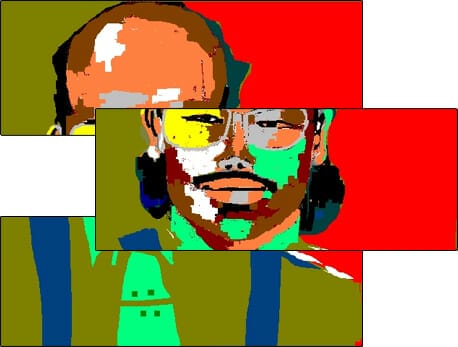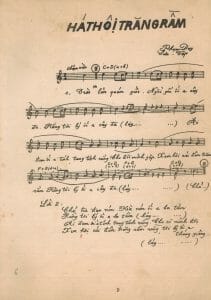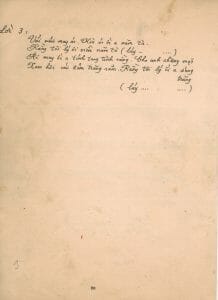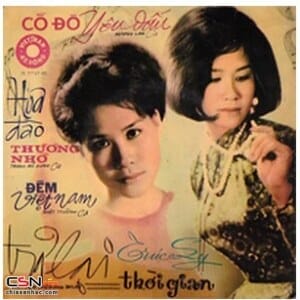“Hát Hội Trăng Rằm” – Dân ca do Phạm Duy sưu tập.
Trình bày: Ban Tam Ca Đông Phương (Pre 75)
Bài dân ca “Hát Hội Trăng Rằm” còn có tên là “Lý Cây Đa”. Trên Website của nhạc sĩ Phạm Duy, bài “Hát Hội Trăng Rằm” được liệt kê theo vần H (Xem ở đây), còn kèm theo cả phóng ảnh bản nhạc ở hình thức tờ nhạc rời xuất bản tháng 9/1971 tại Sài Gòn; mặt khác, khi dò danh sách những bản nhạc bắt đầu với vần L (cũng trên website của NS/PD), chúng tôi không thấy có tên bài “Lý Cây Đa”, dù trong một bài viết khác có liên quan (Hát Lý – một lọai ca dễ thương), nhạc sĩ đã dùng tên “Lý Cây Đa” khi nói về bài dân ca này:
[Trích “Hát Lý – một lọai ca dễ thương“]:
“Thể song thất/lục bát cũng dễ dàng trở thành hát lý, với bố cục giữ nguyên vẹn câu thơ và chỉ thêm tiếng đệm, tiếng lót. Ví dụ bài Lý Kéo Chài :
Gió lên rồi căng buồm cho xướng
Gác chèo lên, ta nướng khô khoai.
(Hò ơ…)
Nhậu cho tiêu hết mấy chai
(Khoan hỡi khoan hò)
Kẻo ghe (mà) nghiêng ngửa
(Khoan hỡi khoan hò)
Không ai chống chèo!
(ơ ơ hờ, là hò ơ…)
Thơ bốn-chữ cũng được dùng trong thể loại dân ca này, ví dụ Lý Cây Ða, Lý Ðò Ðưa, Lý Khỉ Ðột, Lý Ba Cô… Bố cục giản dị, dùng nguyên vẹn câu thơ có tính chất “vè” và có thêm vào những tiếng hát phụ Lý Cây Ða:
Trèo lên quán giốc
Ngồi gốc (ối a) cây đa
(Rằng tôi y y lý ối a cây đa) (2 lần)
Ai (ý) xui (ôi a tính tang ư tình rằng)
(cho đôi) mình gặp
Xem hội (cái đêm) trăng rằm
(Rằng tôi y y lý ối a cây đa (2 lần)
. . .. . . .. .. . . . . . .. . ………..
(hết trích)
Từ đó, chúng tôi suy ra, tên chính của bài dân ca “trèo lên quán giốc” phải là “Hát Hội Trăng Rằm” và sở dĩ có tên “Lý Cây Đa” là vì nó thuộc về một điệu Lý. . . Cây Đa.
Ngòai ra, cũng xin lưu ý, sau này ở hải ngọai cũng có một bài hát theo thể điệu dân ca mang tên “Hát Hội Trăng Rằm” (còn có tên khác là “Em đi xem hội trăng rằm“) với tác giả có tên Nguyễn Nghị, do ca sĩ như Quỳnh hát, có nội dung như sau:
Hát hội trăng rằm
Sáng tác: Nguyễn Nghị
Nhân Gian xem hội trăng tròn,
Trăng tròn mười sáu thật to
Người ta đi đứng thật đông
Ðêm nay là hội trăng tròn
Em đi xem hội trăng tròn
Áo quần hài gấm bảnh bao
Nhìn lên trên trời
Ông trăng soi lên bóng em nằm nghiêng
Ông trăng í a nằm nghiêng
Ông trăng í a nằm nghiêng
Í a í a nằm nghiêng
Nhân gian í a nằm nghiêng
Em đi em lạc lối về
Giữa đường gặp mấy chàng trai
Hỏi thăm con đường nhà em
Quen ra hóa ra gần nhà
Theo nhau đi tìm lối về
Trăng tròn thật sáng đằng sau
Vầng trăng khoác em áo Nguyệt
Soi lên bóng em nằm nghiêng
Hát Hội Trăng Rằm – Sáng tác: Nguyễn Nghị. Trình bày: Như Quỳnh
©T.Vấn 2020
Đọc Thêm:
(Trong phần tìm hiểu thêm về bài dân ca này, chúng tôi xin giới thiệu một bài viết bằng tiếng Anh của cây bút trẻ Vuong Vu với phần giới thiệu tác giả ở cuối bài đọc. Xin phép tác giả Vuong Vu được trích đăng phần viết về bài dân ca “Hát Hội Trăng Rằm” (tức Lý Cây Đa) ở đây):
A Song for Autumn: Lý Cây Đa by Phạm Duy (Ode to the Banyan Tree)
Nguồn: https://www.chopsticksalley.com
Second generation Vietnamese Americans may not be familiar with a song called Lý Cây Đa, but if we ask our parents about it, not only will they recognize the song, chances are they’ve memorized the words. The song was taught to virtually every primary school student in Vietnam, much in the same way we learned Mary Had a Little Lamb in kindergarten. It may have been taught to school children as a language lesson, but there is nothing childish or trivial about the deceptively simple song. Lý Cây Đa is actually poetry with historical and cultural importance. It is a glimpse into the Vietnamese soul.
Lý Cây Đa originated as a form of oral poetry called dân ca. Such poems are passed from one generation to another through recitation, chanting, and often singing. They are often heard in the rice fields while people are working. In fact, it is through popular music that many of these poems survive today. Lý Cây Đa is perhaps the most famous of these songs. It attributed to legendary songwriter and singer Phạm Duy, who traveled throughout villages of northern Vietnam to archive the region’s tradition of poetry and music.
Even though it is attributed to Phạm Duy, the poem has been around for generations. With oral poetry, it is difficult to determine dates and timelines, as there are no written record. What is known is Lý Cây Đa goes back to a more idyllic time when Vietnamese life was centered in villages and the seasonal rhythms of rice farming. It is about a young man and woman, in love, planning to meet at the harvest festival on a full moon night. Here is a recording of the song from 1968:
Ode to the Banyan Tree
Let’s climb the hill and sit at the root of the banyan tree.
We’ll sing an ode to the banyan tree.
Who will bring sorrowful love
For the both of us meet at the full moon festival?
We’ll sing an ode to the banyan tree.
We’ll sing an ode to the banyan tree.
Let’s split bamboo to weave a cone hat, a three-layer cone hat.
We’ll sing an ode to the cone hat, layer by layer.
Who will weave our sorrowful love
For you to wear to the full moon festival?
We’ll sing an ode to the first month of the coming year.
We’ll sing an ode to the first month of the coming year.
With brown cloth, let’s sew a shirt, a tunic shirt.
We’ll sing an ode to the seams of the tunic shirt.
Who will sew our sorrowful love
For you to wear to the full moon festival?
And we’ll sing an ode to the light of the moon.
And we’ll sing an ode to the light of the moon.
Lý Cây Đa
Trèo lên quan dốc ngồi gốc cây đa.
Rằng tôi lý ối a cây đa.
Ai đem tính tang tình rằng
Cho đôi mình gặp xem hội cái đêm trăng rằm?
Rằng tôi lý ối a cây đa.
Rằng tôi lý ối a cây đa.
Chẻ tre đan nón, kìa nón ba tầng.
Rằng tôi lý ối tầng ba tầng.
Ai đan tính tang tình rằng
Cho cô mình đội xem hội cái đêm trăng rằm?
Rằng tôi lý ối a tháng giêng.
Rằng tôi lý ối a tháng giêng.
Vải nâu may áo kìa áo ối a năm tà.
Rằng tôi lý ối viền năm tà.
Ai may ôi à tính tang tình rằng
Cho anh chàng mặc xem hội cái đêm trăng rằm?
Rằng tôi lý ối a sáng trăng.
Rằng tôi lý ối a sáng trăng.
When Pham Duy released the song in the late 1960’s, it struck a nerve with the Vietnamese people. Perhaps it was because Vietnam was divided at the time and war was raging throughout the country, and people longed for a more peaceful time. Perhaps it was because there was a mass migration from the countryside into the cities, and people who were uprooted and relocated were nostalgic for traditional village life. The song resonated with Vietnamese people and it became a national sensation–and remains so to this day.
At a time when I was exploring and struggling with what it means to be Vietnamese, I found the answer in the words of the song. What is it that the young man and woman bring to meet each other at the harvest festival? They bring “tính tang tình rằng.” They wear it; they weave it into their hats and sew it into their clothes. I’ve roughly translated it as “sorrowful love.” It is a rather rudimentary—and even inadequate— translation, but I wanted to capture the essential notion that we Vietnamese carry in our hearts the understanding that life is tragic. Through much of our four thousand years as a people, we have struggled through one famine after another, one war after another, one back breaking rice harvest after another, but we persevere. Despite our tribulations and sorrows, we continue to love, to celebrate, to build, and create beauty. Such is life to us, and we carry this bittersweet understanding in our bones and in our genes, and it makes us who we are—resilient, generous, brave, and poetic.

Vuong Vu
Contributor
Writer and dreamer, Vuong is founder of Tourane Poetry Press and editor of Perfume River Poetry Review. His work has been published in prominent literary journals, and he is a frequent reader at poetry events in the South Bay. His work is an examination of the Vietnamese-American experience, what it means to be Vietnamese so far away from quê hương (motherland). He believes that every Vietnamese is a poet at heart.



